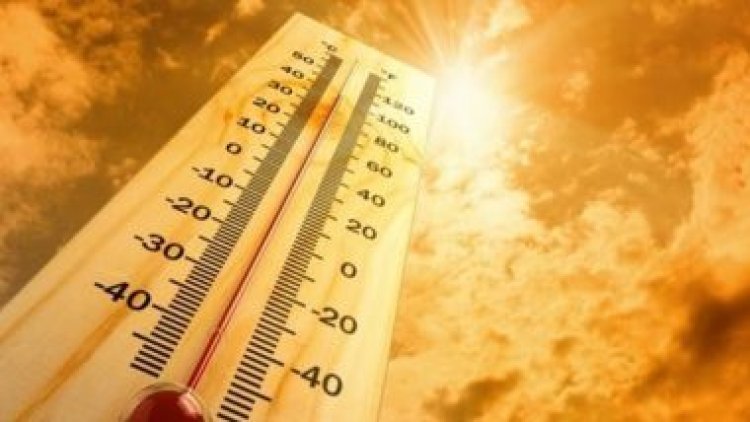Climate change has doubled chances of heatwave in Uttar Pradesh: Report

New Delhi: Climate change at least doubled the chances of heat wave in Uttar Pradesh which swept through the state recently, causing multiple hospitalisations, an analysis conducted using a metric called the Climate Shift Index (CSI) shows.
Developed by Climate Central, an independent US-based group of scientists and communicators, CSI is a tool that quantifies the contribution of climate change to daily temperatures.
Sixty-eight patients died at the district hospital in Uttar Pradesh's Ballia in five days till Monday amid a punishing heat wave in the region. Officials, however, said only two people died due to heat stroke. According to media reports, the neighbouring Deoria district also saw deaths amid extreme heat.
Researchers at Climate Central conducted the analysis using CSI, which measures how often and how much temperatures have shifted from the historical average. A higher index indicates more dramatic change compared to the past.
CSI levels above one indicate climate change. Levels between two and five mean that climate change made those temperatures between two to five times more likely.
The analysis shows that certain parts of Uttar Pradesh reached CSI levels of three, indicating temperatures that have become at least three times more likely due to climate change.
New analysis shows that a three-day extreme heat event over Uttar Pradesh from June 14-16 was made at least two times more likely by human-caused climate change, researchers at Climate Central said.
According to them, extreme temperatures coupled with high humidity contributed to the severity of the event.
"We see again and again that climate change dramatically increases the frequency and intensity of heat waves, one of the deadliest weather events that exist. Our most recent World Weather Attribution (WWA) study has shown that this has been recognised in India, but the implementation of heat action plans is slow.
"It needs to be an absolute priority adaptation action everywhere," said Friederike Otto, the co-lead of WWA, a panel of international experts that study the role of climate change in extreme weather events.
In April, heat and long exposure to the sun claimed 13 lives at a function in Navi Mumbai's Kharghar.
Medical experts say heat stroke occurs when the body's temperature regulation system fails and it overheats.
Common symptoms include a very high body temperature, rapid breathing, rapid heart rate, altered mental state and sometimes dry skin or absence of sweating. However, these symptoms can also occur in other medical emergencies, making it difficult to immediately identify heat stroke as the cause of death.
Heatwave conditions prevailed for around 10 days in east Uttar Pradesh, east Madhya Pradesh, Bihar and Chhattisgarh, and for around 12 days in Odisha, Jharkhand, Telangana, and north coastal Andhra Pradesh in the absence of any rain-producing weather system, according to India Meteorological Department.
A heatwave is declared if the maximum temperature of a station reaches at least 40 degrees Celsius in the plains, at least 37 degrees Celsius in coastal areas and at least 30 degrees Celsius in the hilly regions and the departure from normal is at least 4.5 degrees Celsius.
Heat action plans are the primary policy response to economically damaging and life-threatening heat waves. These prescribe several activities, disaster responses and post-heatwave response measures to decrease the impact of heat waves.
Mariam Zachariah, a researcher at Imperial College London and WWA, said, "The combination of extreme heat and humidity is particularly dangerous for humans, even more so in urban contexts where the heat island effect can further increase temperatures. Unless carbon emissions are rapidly reduced, these life-threatening events will become more frequent and intense."
A report by the IMD in May said most parts of India will see an increase in the duration of heat waves by 12-18 days by 2060.
Heatwaves claimed more than 17,000 lives in 50 years in India, according to a paper authored by M Rajeevan, former secretary of the Ministry of Earth Sciences, along with scientists Kamaljit Ray, S S Ray, R K Giri and A P Dimri.
The paper published in 2021 said India reported 706 heatwave incidents from 1971-2019.
The Fifth Assessment Report of the Intergovernmental Panel on Climate Change highlighted that the rising mortality rate due to heat waves is a major climate risk for South Asian countries.
A moderate increase in average temperatures or a slight increase in the duration of heatwaves can lead to a significant increase in the mortality rate in India unless remedial and response measures are taken, the report stated.
However, heat waves are yet to be officially recognised as a natural disaster at the national level in India. In addition to the immense impact on human health, extreme periods of high temperatures can lead to a significant reduction in crop yields and cause reproductive failure in many crops, as shown by research.
According to a report by the McKinsey Global Institute, about 75 per cent of workers in India experience heat-related stress. The report warns that if this trend continues, the country could lose between 2.5 per cent to 4.5 per cent of its Gross Domestic Product per year by 2030.
India has been experiencing record-breaking temperatures, with 2023 witnessing the hottest February since record-keeping began in 1901. March 2022 was the warmest ever and the third driest in 121 years. The year also saw the country's third-warmest April since 1901.















































